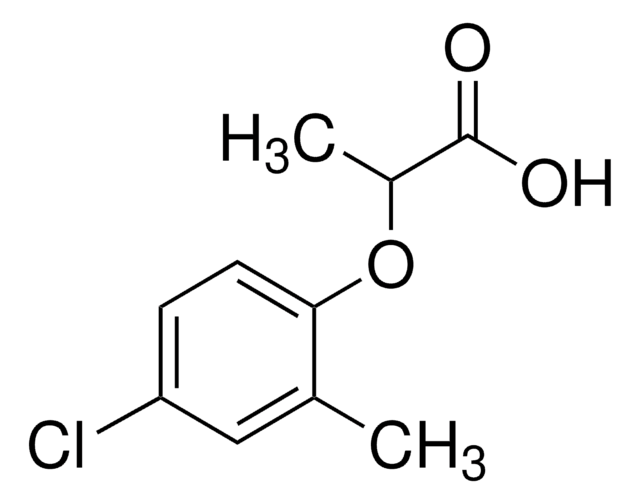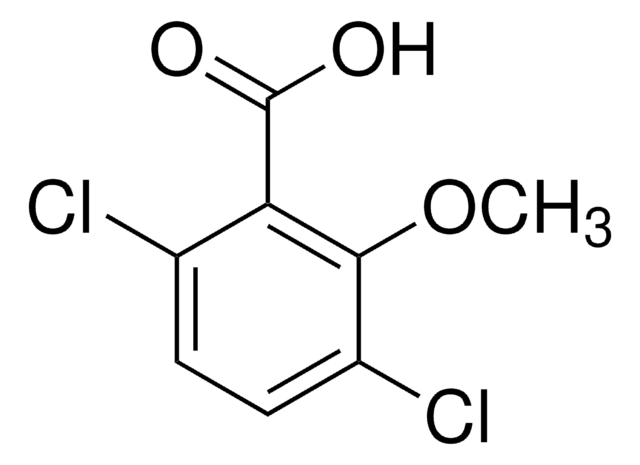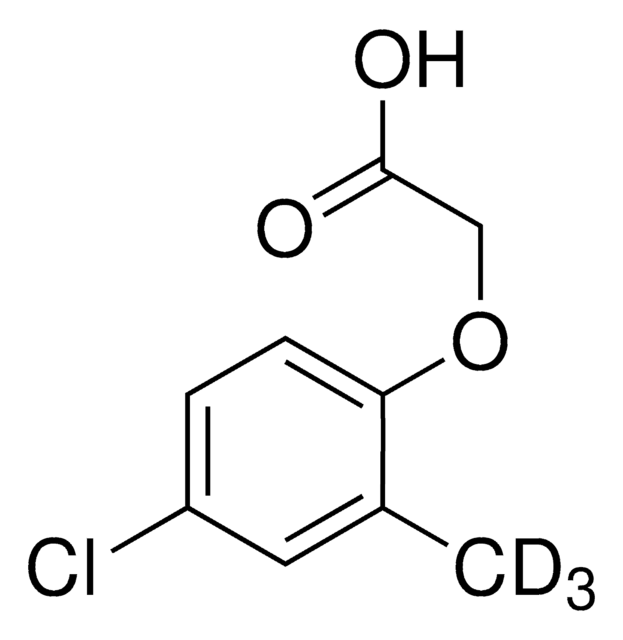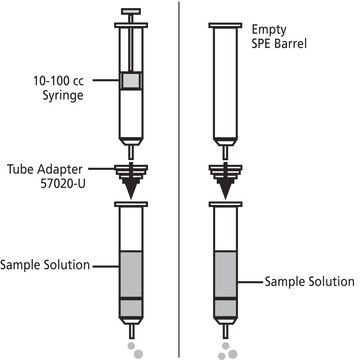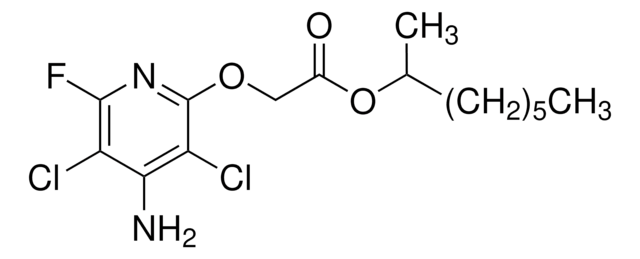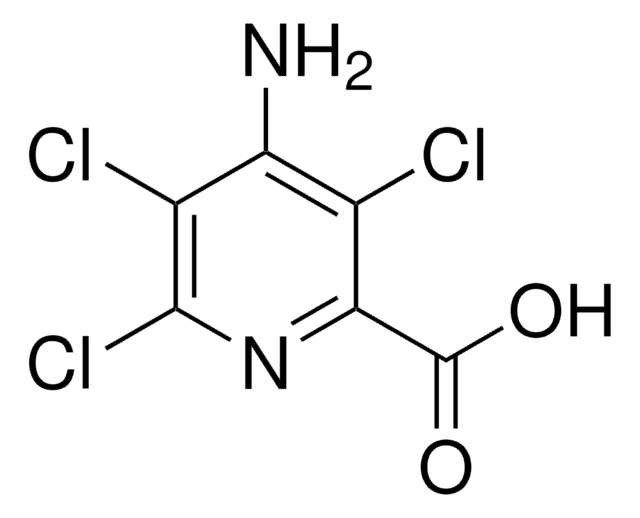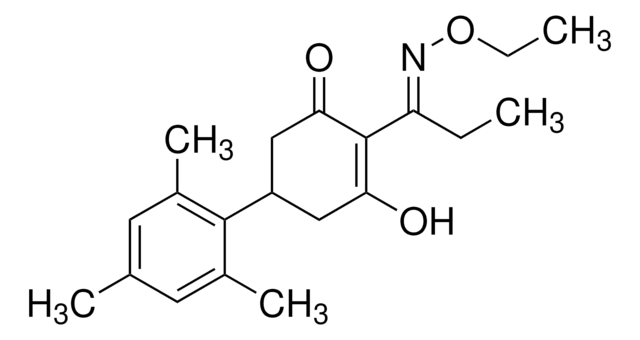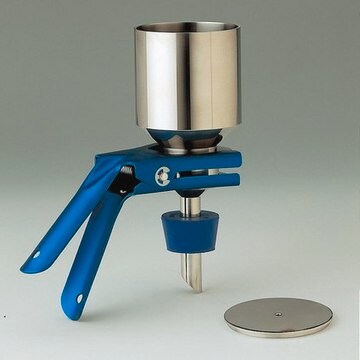Wichtige Dokumente
36773
Mecoprop-P
PESTANAL®, analytical standard
Synonym(e):
(R)-2-(4-Chlor-2-methylphenoxy)-propionsäure
About This Item
Empfohlene Produkte
Qualität
analytical standard
Qualitätsniveau
Produktlinie
PESTANAL®
Haltbarkeit
limited shelf life, expiry date on the label
Anwendung(en)
agriculture
environmental
Format
neat
SMILES String
C[C@@H](Oc1ccc(Cl)cc1C)C(O)=O
InChI
1S/C10H11ClO3/c1-6-5-8(11)3-4-9(6)14-7(2)10(12)13/h3-5,7H,1-2H3,(H,12,13)/t7-/m1/s1
InChIKey
WNTGYJSOUMFZEP-SSDOTTSWSA-N
Suchen Sie nach ähnlichen Produkten? Aufrufen Leitfaden zum Produktvergleich
Allgemeine Beschreibung
Mecoprop-P is approved for its use in the European Union. Maximum residue levels (MRLs) have been set according to Reg (EC) No 149/2008 for mecoprop-P as a sum of mecoprop-P and mecoprop expressed as mecoprop for various products of plant origin from 0.05 to 0.1 mg/kg.
Mecoprop-p was included in Annex I to Directive 91/414/EEC on 01 June 2004. It is listed as one of the active substances in Regulation (EU) No 686/2012 according to the renewal procedure of the approval of active substances submitted under Article 14 of Regulation (EC) No 1107/2009.
Anwendung
- To investigate the relationships between soil depth, the biodegradation of mecoprop-p, and the copy number and diversity of the tfdA gene group
- Study of adsorption and desorption behavior of two phenoxyalkanoic acid herbicides in a Haplic Cambisol with tillage and grassland management using a batch equilibrium method
- To investigate the persistence of S-metalachlor, bentazon, isoproturon, and mecaprop-P in heavy metal contaminated soil before and after EDTA-based remediation
- To assess the effects of mecoprop, mecoprop-p, and their biodegradation compound 2-methyl-4-chlorophenol on two larval stages of Crassostrea gigas
- To study adsorption-desorption Nicosulfuron and the ionic pesticide Mecoprop-P on a calcined Mg-Al hydrotalcite (HT-500) in the presence and absence of various anions
Rechtliche Hinweise
Sie haben nicht das passende Produkt gefunden?
Probieren Sie unser Produkt-Auswahlhilfe. aus.
Signalwort
Danger
H-Sätze
Gefahreneinstufungen
Acute Tox. 4 Oral - Aquatic Acute 1 - Aquatic Chronic 1 - Eye Dam. 1
Lagerklassenschlüssel
11 - Combustible Solids
WGK
WGK 2
Flammpunkt (°F)
Not applicable
Flammpunkt (°C)
Not applicable
Persönliche Schutzausrüstung
dust mask type N95 (US), Eyeshields, Gloves
Hier finden Sie alle aktuellen Versionen:
Analysenzertifikate (COA)
Die passende Version wird nicht angezeigt?
Wenn Sie eine bestimmte Version benötigen, können Sie anhand der Lot- oder Chargennummer nach einem spezifischen Zertifikat suchen.
Besitzen Sie dieses Produkt bereits?
In der Dokumentenbibliothek finden Sie die Dokumentation zu den Produkten, die Sie kürzlich erworben haben.
Unser Team von Wissenschaftlern verfügt über Erfahrung in allen Forschungsbereichen einschließlich Life Science, Materialwissenschaften, chemischer Synthese, Chromatographie, Analytik und vielen mehr..
Setzen Sie sich mit dem technischen Dienst in Verbindung.